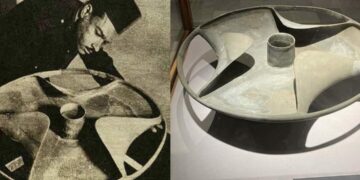The undoubtedly bizarre enclosure wall, entirely separate from the Temple of Jupiter, consists of massive blocks, each weighing an astonishing 900 tons. For decades, historians have claimed to understand our world, offering explanations for nearly everything—except this prehistoric phenomenon. Join us as we explore the Baalbek complex and its wonders, a site unlike anything you’ve ever encountered.
Baalbek is an ancient city located northeast of Beirut, Lebanon. After Alexander the Great conquered it in 334 BCE, the city came under Roman rule and flourished. Today, Baalbek is renowned for the ruins of its Roman-era temple complex, which includes two of the largest and most imposing temples in history: the Temple of Bacchus and the Temple of Jupiter. However, beyond these temples, Baalbek is home to six colossal Roman stone blocks so magnificent that no pictures or videos can truly capture their grandeur. The Baalbek stones are so extraordinary that many believe they deserve to be considered one of the wonders of the world. Thousands of years old, they continue to marvel and perplex researchers attempting to unravel their mystery.
Among these stones, three are slightly smaller but still immense, collectively known as the Trilithon. These three blocks form part of the podium wall within the Roman complex dedicated to the Temple of Jupiter (or Baal, also known as Heliopolitan Zeus), situated atop Tel Baalbek. The size and weight of these stones are staggering—archaeologists estimate each block weighs between 750 and 800 tons. So, who built these massive structures, and how was it possible to move such gigantic blocks? These stones are over a thousand years old, from a time when advanced technology was unimaginable. The precision with which they were placed makes the Baalbek stones one of the most impressive examples of ancient construction. Some historians attribute them to the Phoenicians, while others argue they were built by the Romans. Surprisingly, the stones are crafted from a type of limestone found only in Aswan, Egypt, roughly 1,500 km from Baalbek. What secrets do these stones hold?
Let’s start with what we know. The first is the Stone of the Pregnant Woman, also known as the first monolith, located in an ancient quarry about 900 meters from the grand Heliopolis temple complex. Though the smallest of the three massive monoliths, it remains the most famous due to its excellent preservation and striking angles, unlike anything you’ll ever see. Unlike the other stones, it has never been fully buried, remaining visible for centuries and attracting researchers, historians, and tourists. In 1996, a geodetic team from Linz, Austria, conducted precise topographic measurements to determine the monolith’s exact dimensions and investigate whether it was intended for the Temple of Jupiter. They found the rectangular block measures approximately 20.76 meters in length at the base, 4 meters wide, expanding to 5.2 meters at the top, and 4.32 meters tall. With a density of 2.8 grams per cubic centimeter, it is one of the heaviest quarried blocks in ancient history.
The Stone of the Pregnant Woman’s name has fascinating stories behind it. One tale claims a clever pregnant woman tricked the people of Baalbek, convincing them she knew a secret method to move the stone in exchange for food and care until she gave birth. Another legend involves jinn, supernatural beings in Middle Eastern folklore, said to have cut and moved the stone due to their extraordinary strength. Locals believe touching the stone can increase fertility.
The second monolith, the Stone of the South, was rediscovered in the same quarry during the 1990s. Weighing an estimated 1,279 tons, it surpasses the Stone of the Pregnant Woman in size. Its rediscovery caused confusion, as its location had been forgotten for centuries, leading some to mistakenly refer to it as an alternate name for the Stone of the Pregnant Woman. Its dimensions are astonishing: approximately 20.5 meters long, 4.56 meters wide, and 4.5 meters tall, though parts remain buried.
The third monolith, the Forgotten Stone, was uncovered in 2014 by archaeologists from the German Archaeological Institute. Weighing around 1,650 tons, it is considered one of the largest stones ever quarried. It measures about 19.5 meters in length, 6 meters wide, and 5.5 meters tall. Why these monoliths remain in their quarry, untouched by the construction they were likely intended for, remains a mystery. What halted their use?
The Trilithon, also known as The Three Stones, is a remarkable group of three horizontally placed giant stones forming part of the foundational podium of the Temple of Jupiter at Baalbek, set high on Tel Baalbek. Each stone is approximately 19 meters long, 4.2 meters high, and 3.6 meters thick. Months after their discovery, archaeologists found supporting stones beneath the Trilithon, each weighing around 350 tons and 11 meters wide. How could ancient builders, thousands of years ago, possess the advanced knowledge to align such massive stones with such precision? Moving stones of this size today would require 18 modern heavy-duty cranes, not to mention the challenge of transporting them. Yet, history suggests these stones were moved nearly 1,500 km without paved roads, engines, or sophisticated equipment. Was it sheer manpower, or did they have advanced techniques we’ve yet to uncover?
Legends abound about the Baalbek stones. Some researchers draw from biblical stories, suggesting the builders emulated Noah’s technological expertise, as seen in the construction of the Ark (approximately 137 meters long, 23 meters wide, and 14 meters high, with a volume of 43,000 cubic meters). If Noah could build such a structure, lifting the Baalbek stones might not have been impossible. Some speculate a catastrophic event, like the biblical flood, halted construction, leaving the stones abandoned. Other legends attribute the stones to giants under Nimrod’s command or link them to the Tower of Babel, halted by divine intervention. Local tales suggest Cain built the complex to hide from God’s wrath, while others claim King Solomon enlisted jinn to construct it for the Queen of Sheba, only for the jinn to abandon the project.
Archaeological evidence points to Roman involvement. A graffito dated August 2, 60 CE, found on a column atop the Trilithon, confirms Roman stonemasons worked on the site during the first century CE. A construction plan sketched on one of the Trilithon stones aligns with Roman engineering practices. Excavations beneath the temple revealed Neolithic and Iron Age artifacts, indicating the temple was built after these periods. The podium’s architectural similarities to the Roman-built Temple Mount in Jerusalem further support Roman construction.
However, Graham Hancock proposes an alternative theory, attributing the stones to a lost civilization from 12,000 years ago. He argues their precise cuts suggest advanced technology, possibly lost in a global catastrophe like a comet impact. Hancock disputes Roman involvement, suggesting they built atop an older platform, unaware of the buried stones. Conversely, Zecharia Sitchin claims Baalbek was a Sumerian spaceport for spacecraft to Nibiru, built by the Anunnaki gods, as described in the Epic of Gilgamesh.
The Capstone Theory offers a practical explanation: the Romans used capstans and pulleys, with ropes attached to holes in the stones, and wooden rollers to reduce friction. Calculations suggest 16 capstans, each operated by 32 men, could move these stones. Similar techniques moved the 1,200-ton Thunderstone in the 1770s and the 600-ton Alexander Column, proving ancient methods could handle such feats.
The Baalbek complex remains a phenomenon we may never fully understand. Its wonders continue to captivate. Which part of Baalbek amazes you the most? Let us know in the comments and suggest where we should explore next!























